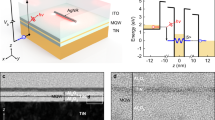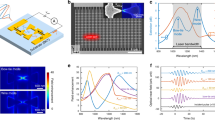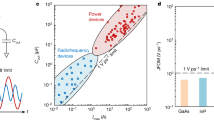Abstract
Photonic elements can carry information with a capacity exceeding 1,000 times that of electronic components, but, due to the optical diffraction limit, these elements are large and difficult to integrate with modern-day nanoelectronics or upcoming packages, such as three-dimensional integrated circuits or stacked high-bandwidth memories1,2,3. Surface plasmon polaritons can be confined to subwavelength dimensions and can carry information at high speeds (>100 THz)4,5,6. To combine the small dimensions of nanoelectronics with the fast operating speed of optics via plasmonics, on-chip electronic–plasmonic transducers that directly convert electrical signals into plasmonic signals (and vice versa) are required. Here, we report electronic–plasmonic transducers based on metal–insulator–metal tunnel junctions coupled to plasmonic waveguides with high-efficiency on-chip generation, manipulation and readout of plasmons. These junctions can be readily integrated into existing technologies, and we thus believe that they are promising for applications in on-chip integrated plasmonic circuits.
This is a preview of subscription content, access via your institution
Access options
Access Nature and 54 other Nature Portfolio journals
Get Nature+, our best-value online-access subscription
$29.99 / 30 days
cancel any time
Subscribe to this journal
Receive 12 print issues and online access
$209.00 per year
only $17.42 per issue
Buy this article
- Purchase on Springer Link
- Instant access to full article PDF
Prices may be subject to local taxes which are calculated during checkout



Similar content being viewed by others
References
Ozbay, E. Plasmonics: merging photonics and electronics at nanoscale dimensions. Science 311, 189–193 (2006).
Brongersma, M. L. & Shalaev, V. M. The case for plasmonics. Science 328, 440–441 (2010).
Arakawa, Y., Nakamura, T., Urino, Y. & Fujita, T. Silicon photonics for next generation system integration platform. IEEE Commun. Mag. 51, 72–77 (2013).
Barnes, W. L., Dereux, A. & Ebbesen, T. W. Surface plasmon subwavelength optics. Nature 424, 824–830 (2003).
Gramotnev, D. K. & Bozhevolnyi, S. I. Plasmonics beyond the diffraction limit. Nat. Photon. 4, 83–91 (2010).
Tan, S. F. et al. Quantum plasmon resonances controlled by molecular tunnel junctions. Science 343, 1496–1499 (2014).
Koller, D. M. et al. Organic plasmon-emitting diode. Nat. Photon. 2, 684–687 (2008).
Neutens, P., Lagae, L., Borghs, G. & Dorpe, P. V. Electrical excitation of confined surface plasmon polaritons in metallic slot waveguides. Nano Lett. 10, 1429–1432 (2010).
Huang, K. C. Y. et al. Electrically driven subwavelength optical nanocircuits. Nat. Photon. 8, 244–249 (2014).
Walters, R. J., van Loon, R. V. A., Brunets, I., Schmitz, J. & Polman, A. A silicon-based electrical source of surface plasmon polaritons. Nat. Mater. 9, 21–25 (2010).
Rai, P. et al. Electrical excitation of surface plasmons by an individual carbon nanotube transistor. Phys. Rev. Lett. 111, 026804 (2013).
Walter, G., Wu, C. H., Then, H. W., Feng, M. & Holonyak, Jr. N. 4.3 GHz optical bandwidth light emitting transistor. Appl. Phys. Lett. 94, 241101 (2009).
Shafir, D. et al. Resolving the time when an electron exits a tunnelling barrier. Nature 485, 343–346 (2012).
Falk, A. L. et al. Near-field electrical detection of optical plasmons and single-plasmon sources. Nat. Phys. 5, 475–479 (2009).
Neutens, P., Van Dorpe, P., De Vlaminck, I., Lagae, L. & Borghs, G. Electrical detection of confined gap plasmons in metal–insulator–metal waveguides. Nat. Photon. 3, 283–286 (2009).
Heeres, R. W. et al. On-chip single plasmon detection. Nano Lett. 10, 661–664 (2010).
Goodfellow, K. M., Chakraborty, C., Beams, R., Novotny, L. & Vamivakas, A. N. Direct on-chip optical plasmon detection with an atomically thin semiconductor. Nano Lett. 15, 5477–5481 (2015).
Lambe, J. & McCarthy, S. L. Light emission from inelastic electron tunnelling. Phys. Rev. Lett. 37, 923 (1976).
Kern, J. et al. Electrically driven optical antennas. Nat. Photon. 9, 582–586 (2015).
Parzefall, M. et al. Antenna-coupled photon emission from hexagonal boron nitride tunnel junctions. Nat. Nanotech. 10, 1058–1063 (2015).
Buret, M. et al. Spontaneous hot-electron light emission from electron-fed optical antennas. Nano Lett. 15, 5811–5818 (2015).
Kirtley, J., Theis, T. N. & Tsang, J. C. Light emission from tunnel junctions on gratings. Phys. Rev. B 24, 5650 (1981).
Dawson, P., Walmsley, D. G., Quinn, H. A. & Ferguson, A. J. L. Observation and explanation of light-emission spectra from statistically rough Cu, Ag, and Au tunnel junctions. Phys. Rev. B 30, 3164 (1984).
Du, W. et al. On-chip molecular electronic plasmon sources based on self-assembled monolayer tunnel junctions. Nat. Photon. 10, 274–280 (2016).
Ward, D. R., Hüser, F., Pauly, F., Cuevas, J. C. & Natelson, D. Optical rectification and field enhancement in a plasmonic nanogap. Nat. Nanotech. 5, 732–736 (2010).
Arielly, R., Ofarim, A., Noy, G. & Selzer, Y. Accurate determination of plasmonic fields in molecular junctions by current rectification at optical frequencies. Nano Lett. 11, 2968–2972 (2011).
Stolz, A. et al. Nonlinear photon-assisted tunneling transport in optical gap antennas. Nano Lett. 14, 2330–2338 (2014).
Sharma, A., Singh, V., Bougher, T. L. & Cola, B. A. A carbon nanotube optical rectenna. Nat. Nanotech. 10, 1027–1032 (2015).
Berndt, R., Gimzewski, J. K. & Johansson, P. Inelastic tunneling excitation of tip-induced plasmon modes on noble-metal surfaces. Phys. Rev. Lett. 67, 3796 (1991).
Bharadwaj, P., Bouhelier, A. & Novotny, L. Electrical excitation of surface plasmons. Phys. Rev. Lett. 106, 226802 (2011).
Le Moal, E. et al. An electrically excited nanoscale light source with active angular control of the emitted light. Nano Lett. 13, 4198–4205 (2013).
Davis, L. C. Theory of surface-plasmon excitation in metal–insulator–metal tunnel junctions. Phys. Rev. B 16, 2482 (1977).
Bigourdan, F., Hugonin, J. P., Marquier, F., Sauvan, C. & Greffet, J. J. Nanoantenna for electrical generation of surface plasmon polaritons. Phys. Rev. Lett. 116, 106803 (2016).
Taflove, A. & Hagness, S. C. Computational Electrodynamics: The Finite-Difference Time-Domain Method 3rd edn (Artech House, Norwood, MA, 2005).
Palik, E. D. Handbook of Optical Constants of Solids (Academic Press, San Diego, CA, 1998).
Johnson, P. B. & Christy, R. W. Optical constants of the noble metals. Phys. Rev. B 6, 437 (1972).
Acknowledgements
The authors acknowledge the National Research Foundation (NRF) for supporting this research under the Prime Minister’s Office, Singapore, under its Medium Sized Centre Programme and the Competitive Research Programme (CRP) (NRF-CRP17-2017-08). H.S.C. acknowledges the support of the A*STAR Computational Resource Centre through the use of its high-performance computing facilities. J. Martin is thanked for useful discussions.
Author information
Authors and Affiliations
Contributions
W.D. fabricated the samples. W.D. and T.W. performed the experiments and analysed the data. T.W. and H.S.C. performed theoretical calculations. C.A.N. conceived and designed the experiments. All authors discussed the results and commented on the manuscript.
Corresponding author
Ethics declarations
Competing interests
The authors declare no competing financial interests.
Additional information
Publisher’s note: Springer Nature remains neutral with regard to jurisdictional claims in published maps and institutional affiliations.
Electronic supplementary material
Supplementary Information
Highly Efficient On-Chip Direct Electronic-Plasmonic Transducers
Rights and permissions
About this article
Cite this article
Du, W., Wang, T., Chu, HS. et al. Highly efficient on-chip direct electronic–plasmonic transducers. Nature Photon 11, 623–627 (2017). https://doi.org/10.1038/s41566-017-0003-5
Received:
Accepted:
Published:
Issue Date:
DOI: https://doi.org/10.1038/s41566-017-0003-5
This article is cited by
-
Upconversion electroluminescence in 2D semiconductors integrated with plasmonic tunnel junctions
Nature Nanotechnology (2024)
-
Controlling Plasmonic Field Enhancement via the Interference of Orthogonal Plasmonic Modes
Plasmonics (2024)
-
Photocurrent as a multiphysics diagnostic of quantum materials
Nature Reviews Physics (2023)
-
Spatiotemporal imaging of the longitudinal and transverse components of the few-cycle surface plasmon polaritons near-field in nano-femto scale by time-resolved photoemission electron microscopy
Applied Physics B (2022)
-
Optical Anisotropy in van der Waals materials: Impact on Direct Excitation of Plasmons and Photons by Quantum Tunneling
Light: Science & Applications (2021)



